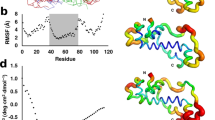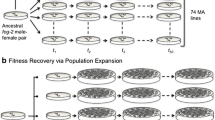Summary
Previous observations have indicated thatDrosophila DNA contains a component that evolves so rapidly that it fails to hybridize between the DNAs of sibling species. To establish the reality of this component and study its properties, the fraction (about 20%) ofDrosophila simulans (Dsim) DNA that fails to hybridize toDrosophila melanogaster (Dmel) DNA has been isolated. The majority of the hybridizable part of this isolated fraction (based on control tests on Dsim DNA) fails to hybridize with Dmel DNA under the conditions used for the initial fractionation. Clones of this fraction do hybridize with Dmel DNA at open criterion producing duplexes with greatly reduced thermal stability, indicating that the underlying process is rapid sequence divergence rather than loss of the homologous sequences by relatively large deletions.
Cloned fragments from the nonhybridizing fraction from Dsim are more than 15% divergent from the Dmel homologues, whereas the fraction that does hybridize is only 3–5% divergent. In comparison, synonymous substitutions in the coding regions of five genes show a 9% average divergence between Dsim and Dmel. They appear to be intermediate in their degree of divergence between the hybridizing and nonhybridizing components.
Similar content being viewed by others
References
Bingham PM, Zachar Z (1989) Retrotransposons and the FB transposon fromDrosophila melanogaster. In: Berg DE, Howe MM (eds) Mobile DNA, American Society for Microbiology, Washington DC, pp 485–502
Britten RJ (1986) Rates of DNA sequence evolution differ between taxonomic groups. Science 231:1393–1398
Britten RJ, Cetta A, Davidson EH (1978) The single-copy sequence polymorphism of the sea urchinStrongylocentrotus purpuratus. Cell 15:1175–1186
Caccone A, Amato GD, Powell JR (1987) Intraspecific DNA divergence inDrosophila: a study on parthenogeneticD. mercatorum. Mol Biol Evol 4:343–350
Caccone A, Amato GD, Powell JR (1988a) Rates and patterns of scnDNA and mtDNA divergence within theDrosophila melanogaster subgroup. Genetics 118:671–683
Caccone A, DeSalle R, Powell JR (1988b) Calibration of the change in thermal stability of DNA duplexes and degree of base pair mismatch. J Mol Evol 27:212–216
Caccone A, Powell JR (1989) DNA divergence among hominoids. Evolution 43:925–942
Catzeflis FM, Sheldon FH, Ahlquist JE, Sibley CG (1987) DNA-DNA hybridization evidence of the rapid rate of rodent DNA evolution. Mol Biol Evol 4:242–253
Davis LG, Dibner MD, Battey JF (1986) Basic methods in molecular biology. Elsevier, New York
Grula JW, Hall TJ, Giugni TD, Graham GJ, Davidson EH, Britten RJ (1982) Sea urchin DNA sequence variation and reduced interspecies differences of the less variable DNA sequences. Evolution 36:665–676
Hall TJ, Grula JW, Davidson EH, Britten RJ (1980) Evolution of sea urchin non-repetitive DNA. J Mol Evol 16:95–110
Hunt JA, Hall TJ, Britten RJ (1981) Evolutionary distances in HawaiianDrosophila measured by DNA reassociation. J Mol Evol 17:361–367
Hutton JR, Wetmur JG (1973) Effect of chemical modification on the rate of renaturation of deoxyribonucleic acid. Deaminated and glyoxalated deoxyribonucleic acid. Biochemistry 12:558–563
Kohne DE, Chiscon JA, Hoyer BH (1972) Evolution of primate DNA sequences. J Hum Evol 1:627–644
Kohne DE, Levison SA, Byers MJ (1977) Room temperature method for increasing the rate of DNA reassociation by many thousandfold: the phenol emulsion reassociation technique. Biochemistry 16:5329–5341
Koop BF, Goodman M, Xu P, Chen K, Slightom JL (1986) Primate η-globin DNA sequences and man's place among the great apes. Nature 319:234–238
Kunkel LM, Monaco AP, Middlesworth W, Ochs HD, Latt SA (1985) Specific cloning of DNA fragments absent from the DNA of a male patient with an X chromosome deletion. Proc Natl Acad Sci USA 82:4778–4782
Kwiatowski J, Gonzalez F, Ayala FJ (1989)Drosophila simulans Cu−Zn superoxide dismutase gene sequence. Nucleic Acids Res 17:6735
Maniatis T, Fritsch EF, Sambrook J (1982) Molecular cloning: a laboratory manual. Cold Spring Harbor Laboratory, Cold Spring Harbor NY
Martin CH, Meyerowitz EM (1986) Characterization of the boundaries between adjacent rapidly and slowly evolving regions inDrosophila. Proc Natl Acad Sci USA 83:8654–8658
Martin CH, Mayeda CA, Meyerowitz EM (1988) Evolution and expression of theSgs-3 glue gene ofDrosophila. J Mol Biol 201:273–287
Meyerowitz EM, Martin CH (1984) Adjacent chromosomal regions can evolve at very different rates: evolution of theDrosophila 68C glue gene region. J Mol Evol 20:251–264
Miyamoto MM, Slightom JL, Goodman M (1987) Phylogenetic relations of humans and African apes from DNA sequences in the ϕη-globin region. Science 238:369–373
Miyamoto MM, Koop BF, Slightom JL, Goodman M, Tennant MR (1988) Molecular systematics of higher primates: genealogical relations and classification. Proc Natl Acad Sci USA 85:7627–7631
Rice NR (1974) Single-copy DNA relatedness among several species of the Cricetidae (Rodentia). Carnegie Inst Year Book 73:1098–1102
Schultz DH, Lee CS (1986) DNA sequence comparison among closely relatedDrosophila species in themulleri complex. Genetics 113:287–303
Sharp PM, Li W-H (1989) On the rate of DNA sequence evolution inDrosophila. J Mol Evol 28:398–402
Sibley CG, Ahlquist JE (1987) DNA hybridization evidence of hominoid phylogeny: results from an expanded data set. J Mol Evol 26:99–121
Zweibel LJ, Cohn VH, Wright DR, Moore GP (1982) Evolution of single-copy DNA and the ADH gene in seven drosophilids. J Mol Evol 19:62–71
Author information
Authors and Affiliations
Rights and permissions
About this article
Cite this article
Werman, S.D., Davidson, E.H. & Britten, R.J. Rapid evolution in a fraction of theDrosophila nuclear genome. J Mol Evol 30, 281–289 (1990). https://doi.org/10.1007/BF02099998
Received:
Issue Date:
DOI: https://doi.org/10.1007/BF02099998




